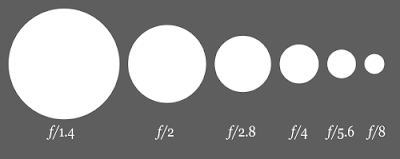What is a Stop?
In photography the word stop refers to the lens diaphragm which regulates the amount of light passing through the lens.
However the term stop is also used to quantify light, meaning it is used as a measure of light. When the quantity of light emitted by a light source, falling on a subject or reaching the camera’s sensor is doubled or halved, it is termed as 1stop more or 1 stop less of light.
Measure of Light
Flash power is also stated in stops; when the flash power is doubled it is called a 1stop increase in light and when the flash power is halved it is called a 1 stop decrease light.
Similarly when lighting a subject for photography doubling the quantity of light falling on the subject is termed as 1stop more and halving the quantity of light falling on the subject is termed 1stop less of light.
Stop is also used to compare ISO. When the ISO is doubled for example from ISO 100 to ISO 200 it is a 1stop increase in ISO and hence double the sensitivity to light.
What is F/Stop?
In photography F/stop is used to define a specific quantity of light entering the camera. F/stop number refers to the size of the opening of the lens aperture diaphragm. However the relationship between the f/stop numbers and the size of opening of the lens aperture is not proportional and hence smaller f/stop numbers (f/1.4, f/2.8) denotes larger apertures and larger f/stop numbers (f/22, f/32) denotes smaller aperture opening. F/stop is one of the elements that determine the depth of field in a picture.
 |
| Image source - Wikipedia |
F/stop is thus used to quantify light as an aperture value worth of light. It could be light emitted by the light source, light falling on a subject or light reaching the camera’s sensor. A flash unit could be said to provide f/4 worth of light and when its output is doubled it now puts out one stop more of light which is equivalent to f/5.6.
F/stop is determined by the following equation explains why a small opening on a wide angle lens lets in the exact same quantity of light as a much larger opening on a telephoto lens.
Focal length F/stop
----------------
Diameter of the aperture = 1.4
2
2.8
4
5.6
8
11
16
22
F/stop is determined by the following equation explains why a small opening on a wide angle lens lets in the exact same quantity of light as a much larger opening on a telephoto lens.
F/stop = Focal length of the lens / Diameter of the aperture
Focal length F/stop
----------------
Diameter of the aperture = 1.4
2
2.8
4
5.6
8
11
16
22
 |
| Image Source - Wikipedia |
As per the equation Diameter of aperture = focal length/f/stop
So diameter of aperture of a 100mm lens at f/4 = 100/4 = 20
And diameter of aperture of a 200mm lens at f/4 = 200/4 = 50
These two terms are the ones that confuse most beginner photographers when they hear it used in different contexts with different meanings. However it is such photographic jargon's that help photographers communicate effectively with each other. So if you are a beginner in photography it is better to learn what these terms means in different contexts sooner rather than later, as you will encounter them on a daily basis as you advance in your photographic career.
So diameter of aperture of a 100mm lens at f/4 = 100/4 = 20
And diameter of aperture of a 200mm lens at f/4 = 200/4 = 50
These two terms are the ones that confuse most beginner photographers when they hear it used in different contexts with different meanings. However it is such photographic jargon's that help photographers communicate effectively with each other. So if you are a beginner in photography it is better to learn what these terms means in different contexts sooner rather than later, as you will encounter them on a daily basis as you advance in your photographic career.
Post a Comment